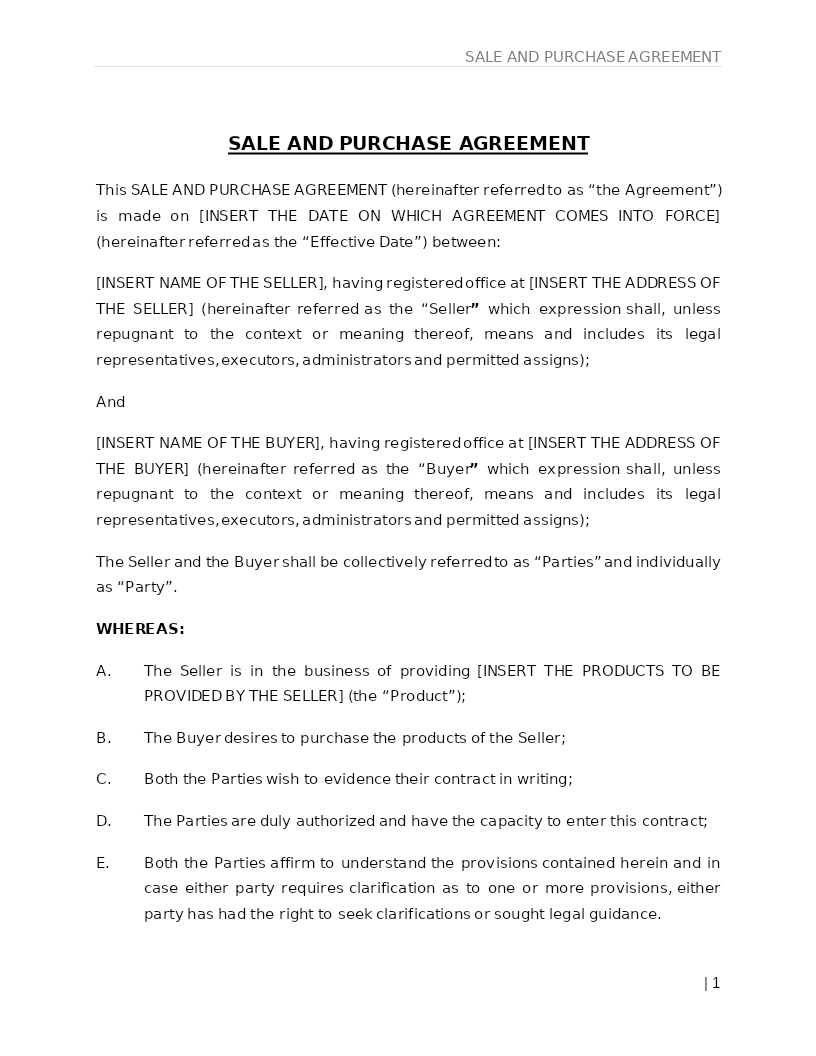
SALE AND PURCHASE AGREEMENT
How does it work?
1. Choose this template
Start by clicking on "Fill out the template"
2. Complete the document
Answer a few questions and your document is created automatically.
3. Save - Print
Your document is ready! You will receive it in Word and PDF formats. You will be able to modify it.
What is a Sale and Purchase Agreement?
A Sale and Purchase Agreement (SPA) is a legally binding contract that outlines the terms and conditions under which a seller agrees to sell, and a buyer agrees to purchase, certain assets, goods, or shares. It defines the obligations, representations, warranties, and closing conditions applicable to the transaction, ensuring clarity and legal enforceability. SPAs are commonly used in a wide range of commercial transactions including the sale of businesses, shares, property, or goods and serve as the foundation of the transfer of ownership between parties.
A well-drafted Sale and Purchase Agreement provides transparency, allocates risks appropriately, and safeguards the interests of both the buyer and the seller throughout the transaction lifecycle.
This template is:
• Lawyer-drafted and legally neutral, adaptable for use across multiple jurisdictions.
• Applicable to asset, share, or property purchase transactions.
• Covers representations, warranties, payment terms, closing, and dispute resolution.
• Customizable for individual, corporate, or cross-border transactions.
Key Features of a Sale and Purchase Agreement
1. Parties to the Agreement
Identifies the Seller (party transferring ownership) and the Buyer (party acquiring the asset), including their full legal names, addresses, and registration details, where applicable.
2. Description of the Subject Matter
Clearly defines the asset(s), goods, property, or shares being sold, including all material specifications, conditions, and accompanying rights, licenses, or accessories.
3. Purchase Price and Payment Terms
Specifies the total purchase consideration, currency, payment schedule, mode of payment, and any deposit or adjustment mechanisms (e.g., working capital or completion accounts).
4. Representations and Warranties
Outlines statements made by the seller and buyer to assure the accuracy of information provided, including ownership, title, compliance, absence of encumbrances, and legal capacity.
These provisions protect both parties and form the basis for indemnification in case of breach or misrepresentation.
5. Conditions Precedent
Lists specific obligations or actions to be fulfilled before the transaction can be completed such as regulatory approvals, third-party consents, due diligence, or payment of taxes.
6. Closing and Completion
Defines the closing date, deliverables at completion (e.g., execution of transfer documents, delivery of title deeds, or handover of possession), and the legal effect of completion.
7. Title and Risk Transfer
Specifies when ownership and risk in the asset pass from the seller to the buyer usually upon completion or delivery ensuring a clear demarcation of liability.
8. Covenants and Obligations
Sets out post-signing obligations such as maintenance of assets, conduct of business in the ordinary course, confidentiality, and non-compete obligations, where relevant.
9. Indemnity and Limitation of Liability
Provides mechanisms for compensation in case of breach, inaccuracy of warranties, or undisclosed liabilities, while limiting exposure through caps, thresholds, or time limits.
10. Termination and Remedies
Allows termination under specific conditions such as material breach, non-fulfilment of conditions precedent, or failure to close by an agreed date, and details the remedies available to the aggrieved party.
11. Confidentiality
Ensures that all proprietary, financial, and business information exchanged during negotiations or performance remains confidential, except as required by law.
12. Governing Law and Dispute Resolution
Specifies the governing law and mechanism for resolving disputes commonly through negotiation, mediation, or arbitration. This clause is adaptable for domestic or cross-border use.
Why You Need a Sale and Purchase Agreement
• Establishes clear and enforceable terms for sale and ownership transfer.
• Protects both parties through representations, warranties, and indemnities.
• Reduces transactional and legal risks during due diligence and completion.
• Ensures transparency and trust in commercial or property transfers.
• Facilitates smooth execution and dispute-free closure of transactions.
FAQs on Sale and Purchase Agreements
Q1: Is a Sale and Purchase Agreement legally binding?
Yes. Once signed by both parties, the SPA becomes a legally enforceable contract outlining rights and obligations of each party.
Q2: What is the difference between an SPA and a Memorandum of Understanding (MOU)?
An MOU records preliminary intentions, while an SPA sets out the final, binding terms of the sale and purchase.
Q3: Can an SPA be used for both assets and shares?
Yes. The structure remains similar, though share SPAs focus on ownership of equity, while asset SPAs involve transfer of tangible or intangible assets.
Q4: Is a deposit or advance payment mandatory?
Not necessarily. While commonly used to secure performance, the requirement and percentage of deposit depend on commercial negotiation.
Q5: Can the SPA be executed electronically?
Yes. SPAs can be signed electronically and are recognized under most global e-signature laws, including the UNCITRAL Model Law, E-SIGN Act (US), and IT Act (India).
Q6: What happens if either party breaches the agreement?
The non-breaching party may terminate the agreement and seek remedies such as damages, specific performance, or rescission, subject to the governing law and dispute resolution clause.
Related Templates You May Need
• Non-Disclosure Agreement (NDA)